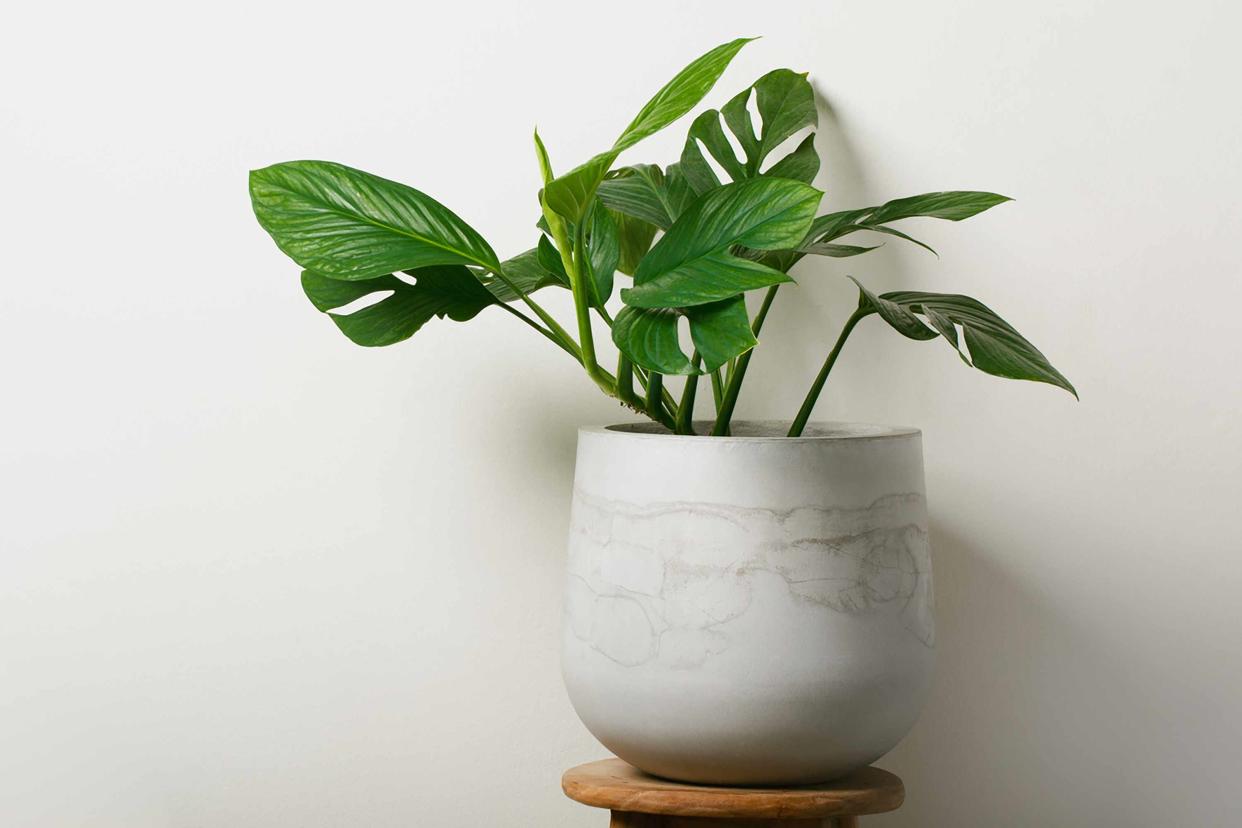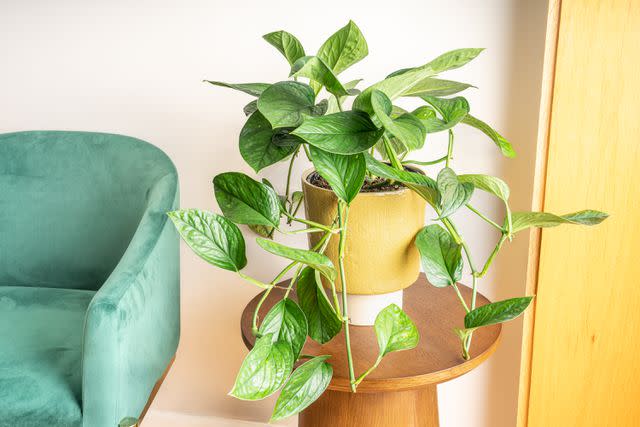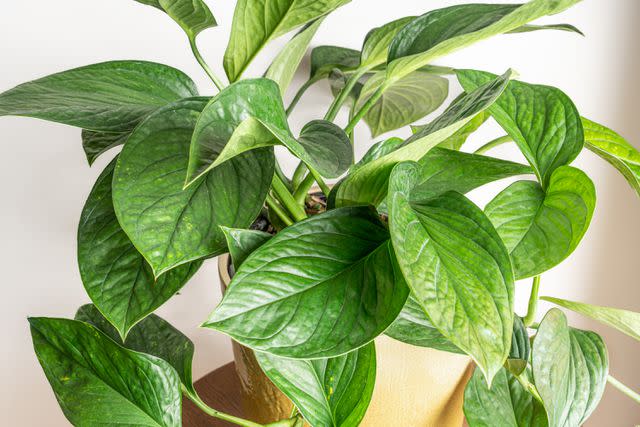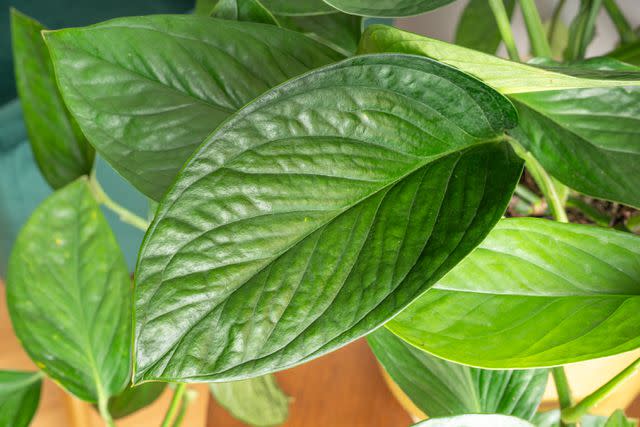How to Grow and Care for Monstera Pinnatipartita

bgton / Getty Images
Monstera pinnatipartita is a rare variety in the monstera genus prized for its fenestrated foliage. This evergreen climbs with epiphytic aerial roots and can grow up to 2 feet a year if indoor growing conditions are optimal.
What sets this rare species apart is that the fenestration extends further up the dark green, heart-shaped leaves than you see in some of the more familiar monsteras. Despite their show-stopping appearance, these plants are surprisingly easy-to-care-for.
While mature plants certainly have the wow factor, the smaller foliage on juvenile plants is solid rather than fenestrated. You'll need patience for the payoff if you buy a baby. And it isn't the preferred pick if you have pets that like to munch on vegetation. Monsteras contain insoluble calcium oxalates, making them toxic plants for pets.
Botanical Name | Monstera Pinnatipartita |
Family | Araceae |
Plant Type | Perennial |
Mature Size | Up to 6 ft indoors and over 30 ft. outdoors |
Sun Exposure | Partial |
Soil Type | Moist, Well-drained |
Soil pH | Acidic, Neutral |
Bloom Time | Does not bloom indoors |
Flower Color | White |
Hardiness Zones | 10 - 12 (USDA) |
Native Area | Central and South America |
Toxicity | Toxic to pets |
Monstera Pinnatipartita Care
Here are the main care requirements for growing a Monstera pinnatipartita:
Place in a well-lit location without intense direct sunlight, an east-facing window is ideal.
Keep soil evenly moist in a pot with good drainage.
Pot in soil with ready-made monstera or aroid mix, or create a blend that balances draining and moisture-retaining qualities.
Maintain humidity levels above 50% with a humidifier, pebble tray, or steamy bathroom.
Support mature pinnatipartita, which are tall with a climbing habit, with a moss pole or trellis support to stop them from drooping and promote healthy growth.

The Spruce / Danielle Moore

The Spruce / Danielle Moore

The Spruce / Danielle Moore
Light
Getting things right in terms of light levels is key to ensuring healthy, glossy foliage that develops first-rate fenestration. If the plant doesn't get enough light, it can get leggy, and the leaves won't split well.
In their native tropical setting, Monstera pinnatipartita would receive dappled light on the forest floor. A well-lit location without intense direct sunlight, like that from an east-facing window, is ideal. If you're going for a south- or west-facing window spot, don't have the plant too close to it, otherwise the direct sun during the brightest part of the day could scorch the foliage.
Only have a north-facing aspect? You might need to use supplemental grow lights to give your plant the light it needs to thrive. For best result, your Monstera pinnatipartita will need at least six hours of bright but indirect light.
Regularly rotate the pot to ensure even light hits all angles of this big plant.
Soil
Dense soil is a no-no for this epiphytic species. The plant needs light, well-aerated mixes with some nutrient-rich organic material mixed through. Blending in vermiculite, orchid bark, and sustainable coco coir are great options.
Alternatively, look for a ready-made monstera or aroid mix which balances the draining and moisture-retaining qualities this plant loves. Using a moss pole means the plant can also draw nutrients from the pole.
Water
Monstera pinnatipartitas benefit from evenly moist soil. Soggy conditions aren't this plant's friend and can lead to root rot. When the top few inches of soil are fully dry, that's a good indicator of when it's time to water. Because these large plants sit in deep soil, if you want to be sure the root ball isn't still wet, use a moisture meter to check.
A pot with good drainage holes is a necessity. Irrigate until you spot the water running out the bottom of the pot, and drain away any excess pooled water. Typically, you'll need to water every one to two weeks during the growing season, depending on humidity levels.
Temperature and Humidity
It's no surprise that these tropical rainforest natives love warm, humid conditions. Ideal temperatures for Monstera pinnatipartitas are 65 to 85 Fahrenheit and away from drafts and blasting heating vents. The higher the temperatures, the faster the growth and the more impressive the fenestration.
Unattractive dry, curling leaves are a problem if they aren't getting enough moisture. Aim for humidity levels above 50%, and your plant will thank you if you can get it higher. This is an ideal plant for a steamy bathroom. But, if you're struggling to find a spot in your home with the right humidity levels, invest in a humidifier and group the plant with other humidity-loving epiphytes to take advantage of the collective respiration.
Fertilizer
Feeding your Monstera pinnatipartita regularly during the spring and summer growing seasons helps promote impressive leaf development. Your plant will appreciate a slow-release balanced 20-20-20 liquid fertilizer. If you can find one designed for monsteras, this will have an optimal mix of nutrients. Cut back to once-a-month feeding or less during the slow winter months.
Pruning
If the aerial roots are starting to look untidy, you can trim these up or tuck them back down into the pot. Trim away unhealthy leaves to direct energy to healthy foliage growth. If the plant is getting too tall for your space, trim it back during the spring using sterile cutting shears. Take at most 25 percent off the plant height.
Propagating Monstera Pinnatipartita
One big benefit of this beautiful plant is its ability to propagate, and there are a few methods you can experiment with in the spring.
How to Propagate in Soil
Using sterile shears, take a 4- to 6-inch cutting of a healthy stem about a half-inch below an intact leaf node.
Remove any foliage that remains on the bottom third of the cutting.
Dip the cut end into a rooting hormone.
Put the cutting into a moist, loose soilless growing medium in a container with good drainage holes.
Place the container in a spot with bright but indirect light.
Keep the potting mix moist but not saturated.
Check for well-formed roots after two to three months. At this point, you can move the cutting to a larger pot.
How to Propagate in Water
Using sterile shears, take a 4- to 6-inch cutting from a healthy stem about a half-inch below an intact leaf node.
Place the cutting in a tall, clear glass water container in a bright position out of direct sunlight.
Ensure the leaf remain out of the water.
Replace with fresh water every week.
The cutting is ready to plant when the roots are at least an inch long. Expect this to take up to two months.
How to Propagate by Air Layering
Pick a healthy stem with at least one intact node and a healthy leaf.
Using sterile shears, make a small cut to create a notch in the stem just under the node. Be careful when cutting the notch—the slit shouldn't be more than 1/4 inch deep.
Place some moist sphagnum moss in a plastic bag with small holes punched in the bottom.
Snip the top end of the bag to allow you to create flaps that will wrap around the stem.
Push the moss against the node and wrap the bag flaps around the stem.
Hold the bag in place with cable ties or string so that you fully enclose the node section in the bag with the moss against it.
Watch for roots growing. If the moss is drying out, spray it to remoisten (not soak) it.
When the roots are at least one inch long (it can take up to two months), carefully remove the bag and cut off the rooting stem to plant up in a potting medium.
Potting and Repotting Monstera Pinnatipartita
Mature specimens are big and, in the right conditions, they might benefit from repotting once every year or two. Repot in the spring in advance of the significant growth spurt. Pick a pot that is around 3 inches wider than the root ball with good drainage holes.
Common Pests and Plant Diseases
Regularly wipe off the foliage with a damp cloth. Not only will this remove dust and keep the leaves looking glossy, but it also helps minimize the chance of pests setting up camp in your home. Monstera pinnatipartitas can sometimes experience problems with mealybugs and spider mites. Applying neem oil or insecticidal soap can help rid the plants of these pests before the populations become a major problem.
Common Problems With Monstera Pinnatipartita
The large, split leaves of a mature Monstera pinnatipartita need some TLC to keep them looking their best. Watch out for these issues and make adjustments to help your plant thrive.
Drooping Leaves
If temperatures drop too much in your home, the leaves could start to droop and die off. Check temperatures are above 60 degrees Fahrenheit and move to a warmer spot if not.
Yellowing Leaves
The most common reason for yellowing leaves in Monstera pinnatipartitas is overwatering. Cut back on your watering schedule and check the top few inches of soil is fully dry before irrigating again.
Browning Leaves
If you leave your Monstera pinnatipartita dry for too long or put it in intense sunlight, the leaves can start to curl and brown. Try upping your watering schedule (without creating soggy conditions) and move your plant to a place that's still bright but not blinding.
Brown spots can also indicate that your plant isn't getting enough humidity. Keep your plant away from heating vents, and consider moving to a steamy bathroom or investing in a humidifier.
Frequently Asked Questions
How long do Monstera pinnatipartita live?
If you can provide optimal care and growing conditions, your Monstera pinnatipartita could be a heirloom plant you can enjoy for over 40 years.
How is the Monstera pinnatipartita different from the Monstera deliciosa?
The Monstera pinnatipartita is similar to its Monstera deliciosa cousin. The Monstera deliciosa is the most Instagrammable and popular species, but Monstera pinnatipartita is a rarer variety also prized for its fenestrated foliage. The biggest difference between these two plants is that the pinnatipartita has more deeply split leaves.
How fast does the Monstera pinnatipartita grow?
Your plant could grow as much as 1 to 2 feet annually in optimal conditions, reaching maturity in as little as 3 years.
Read the original article on The Spruce.

